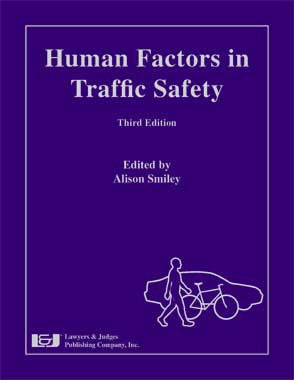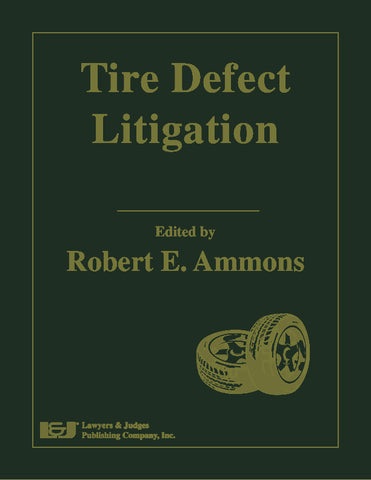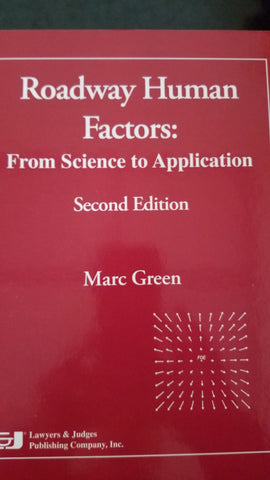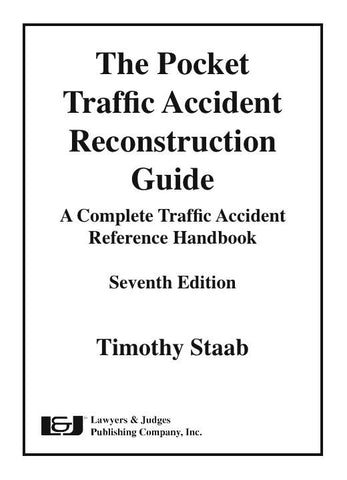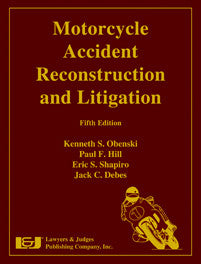
Motorcycle Accident Reconstruction and Litigation, Fifth Edition with Hurt Report on DVD
- Author: Kenneth S. Obenski, Paul F. Hill, Eric S. Shapiro, Jack C. Debes
- ISBN 10: 1-933264-98-5
- ISBN 13: 978-1-933264-9-81
- Copyright Date Ed: February 1, 2011
- Pages: 416
- Binding Information: Casebound
- Size: 8.5 ✕ 11 Inches (US)
Learn motorcycle accident reconstruction techniques from the experienced authors of this book. The special mechanics of riding a motorcycle and the way a motorcycle performs mechanically are explained in nontechnical terms. Quasi-motorcycles are compared and contrasted with standard motorcycles to acquaint the reader with their similarities and differences. Rider safety considerations and human factors issues such as conspicuity, evasive action, warning to the rider, and rider experience and training are discussed in detail. Visual perception and injury biomechanics are given extensive coverage. A wide variety of motorcycle accidents are reconstructed and explained to illustrate the most useful, successful and often specialized techniques for reconstructing these accidents.
The legal aspects of motorcycle use are thoroughly covered, including helmet laws, negligence, laws governing accidents, accidents on public and private property, trespassing, warnings, roadway defects, motorcycle defects, injury to passengers, and Dram Shop liability in DUI cases. Case examples are included for each topic. These case studies have been revised, updated and expanded to include the most recent information for this fifth edition.
This edition includes accident cause factors and identification of countermeasures, commonly known as "The Hurt Report," on DVD. This important government study has never been repeated.
This book is also available as an eBook. Click here to purchase and download:
TOPICS INCLUDE:
- Mechanical aspects of motorcycles
- Motorcycle operations
- Quasi-motorcycles
- Accident investigation techniques and methods
- Collisions with backing, parked, stalled, disabled or slow vehicles
- Collisions with pedestrians
- Collisions with domestic and wild animals
- Collisions with moving vehicles
- Collisions at intersections
- Motorcycle and other vehicle meeting
- Motorcycle or driver overtaking
- Rider behavior and human factors issues
- Motorcycle injury biomechanics
- Visual perception and conspicuity
- Rider protection and safety
- Defects in public roads
- Defects on private land
- Warnings
- Helmets: compulsory use
- Helmets: negligence for not wearing
- Product liability
- Entrustment and supervision
- Passengers and negligence
- Release of liability when participating in motorcycle events
- Negligence of servers of alcohol in motorcycle DUI cases
Table of Contents
Part I: Forensic Engineering Reconstruction of Motorcycle Accidents
Chapter 1: Understanding Motorcycles
Kenneth S. Obenski, P.E.
1.1 Definition
1.2 Steering
1.3 Countersteering
1.4 Handling
1.5 Articulated?
1.6 Brakes
1.7 Acceleration
1.8 Transmissions and Drive Lines
1.9 Engines
1.10 Tires and Wheels
1.11 Controls
1.12 Weather
1.13 Life Expectancy
1.14 Sidestands
1.15 Modifications
Chapter 2: Braking
Kenneth S. Obenski, P.E. and Eric Shapiro, A.S.E.
2.1 General Considerations
2.2 Integrated Brakes
2.3 Anti-Skid Brake System (ABS)
A. Latest Effect on Fatalities by ABS-Equipped Motorcycles
2.4 Braking on Curves
2.5 Failures
References
Chapter 3: Tires and Wheels
Kenneth S. Obenski, P.E. and Eric S. Shapiro, A.S.E.
3.1 General Principles
3.2 Motorcycle Tire Nomenclature
A. Tire Size
B. Load Capacity
C. Direction Arrow
D. Speed Rating
E. Tread Wear Indicator
F. DOT (or Tire Identification) Number
G. Construction
H. Forensic Usefulness
3.3 Front
3.4 Rear
3.5 New Tires
3.6 Flats
3.7 Tube versus Tubeless
3.8 Rain Grooves
3.9 Hydroplaning and Wet Traction
3.10 Wheels
3.11 Traction
Chapter 4: Highway Factors
Kenneth S. Obenski, P.E.
4.1 Pavement Marking
4.2 Blocked Visibility
4.3 Invisibility
4.4 Ruts and Expansion Joints
4.5 Rails
4.6 Edge of Pavement Steps
4.7 Grooves and Gratings
4.8 Guardrails
4.9 Posts
4.10 Debris
4.11 Steel
4.12 Gates
4.13 Animals
4.14 Animal Waste
4.15 Intersections
Chapter 5: Conspicuity
Kenneth S. Obenski, P.E.
5.1 Exhaust Pipes
5.2 Horns
5.3 Lights and Coloration
5.4 Psychology
5.5 Clothing
5.6 Riding Behavior
Chapter 6: Rider Factors
Kenneth S. Obenski, P.E.
6.1 Experience
6.2 Beginners
6.3 Maturity
6.4 Training
6.5 Drugs
6.6 Choice of Bike
6.7 Rider Behavior
A. Lane splitting
B. Curb sneaking
C. Lane sharing
D. Lane position
E. Moving up on traffic
F. Aggressively defensive
6.8 Rider Performance
A. Reaction time
B. Braking
C. Steering
6.9 Wobbles
6.10 Passengers
Chapter 7: Rider Protection
Kenneth S. Obenski, P.E.
7.1 The Best Rider Crash Protection
7.2 Helmets
7.3 Crash Bars
7.4 Eye Protection
7.5 Seat Belts!
7.6 Air Bags
7.7 Roll Bars
7.8 Weather
7.9 Clothing
Chapter 8: Wobbles and Weaves
Kenneth S. Obenski, P.E.
8.1 Types
A. Simple wheel wobble
B. Front-end wobble
C. High-speed weave
D. “Flopping”
E. Induced wobble
F. High-side
8.2 Geometry
8.3 Causes
8.4 Evidence
Chapter 9: Evasive Action
Kenneth S. Obenski, P.E.
9.1 Lay It Down
9.2 Lane Change
9.3 Leading the Target
9.4 Countersteering
9.5 Slam on the Brakes
9.6 Swerve, then Brake
9.7 Brake First, then Swerve
9.8 Brake and Swerve Simultaneously
9.9 Jumping
9.10 Pick a Soft Place to Crash
Chapter 10: Quasi-Motorcycles
Kenneth S. Obenski, P.E.
10.1 Mopeds and Motorized Bicycles
10.2 Motor-Driven Cycle (“No-Ped”)
10.3 Scooters
10.4 Minibikes
10.5 Mini Scooters
10.6 Oddball Scooters
10.7 Multi-Wheel Cycles
10.8 Trikes
10.9 ATCs
10.10 Sidecars
10.11 Trailers
10.12 Three-Wheel Cars (e.g., Morgan and Trihawk)
Chapter 11: Inquiries
Kenneth S. Obenski, P.E.
11.1 Identification of Vehicle Make and Model
11.2 Photographs
11.3 Injuries
11.4 Headlights
11.5 Perceptions
11.6 Clothing
11.7 Mechanical
A. Gearshift
B. Brakes
C. Tires
D. Sidestands
E. Modifications
11.8 Experience
11.9 How-To
11.10 Road Conditions
11.11 Witnesses
11.12 Publications
11.13 More on Photographs
Chapter 12: Methods
Kenneth S. Obenski, P.E.
12.1 Speed Estimates
12.2 Speed from Skid
12.3 Uncertainty Cuts Both Ways
12.4 Speeds from Scrapes and Gouges
12.5 Speed from Flight
12.6 Speed from Momentum
12.7 Speed from Rotation of Car
12.8 Speed from Damage
12.9 Speed from Frame Damage
12.10 Speed from Radius
12.11 Relative Speed from Tire Markings
12.12 Injuries
12.13 Speed from Acceleration
Chapter 13: Safety, or Why the Blank Do People Ride Those Blankety-Blank Things?
Kenneth S. Obenski, P.E.
13.1 The Attraction
13.2 Visceral Involvement
13.3 Comparison
13.4 Public Attitude
13.5 Dearth of Statistics
13.6 Why Not?
Chapter 14: Visual Perception and Motorcyclists’ Conspicuity
Bernard Abrams, O.D. and Leslie Weintraub, O.D.
14.1 Introduction
14.2 Accident Statistics
14.3 Conspicuity is a Significant Factor
14.4 Human Factors: How the Eyes Work
14.5 Dynamic Visual Acuity Is Related to Driving
14.6 Daytime versus Nighttime Vision
14.7 Glare
14.8 Contrast Sensitivity
14.9 Human Factors: The Brain Is in Charge
14.10 Human Factors: Response to a Crisis Takes Time
14.11 Back to Conspicuity
14.12 Studies of Conspicuity
14.13 Ways to Increase Conspicuity
14.14 Eye Protection Is Vital
14.15 Helmets from the Vision Perspective
Endnotes
Chapter 15: Anatomy of a Well-Managed, Well-Funded Case and Things That Happen Way Too Often
Kenneth S. Obenski, P.E.
15.1 Getting Retained
15.2 The History
15.3 Investigation
15.4 Personalities
15.5 Preparation
15.6 Deposition
15.7 Trial
Chapter 16: Motorcycle Steering Revisited (Because Not All Is As It Seems)
Eric S. Shapiro, A.S.E.
16.1 Introduction
16.2 Riding Categories
16.3 Motorcycle Steering
16.4 Conclusion
Chapter 17: Primary versus Secondary Safety
Eric S. Shapiro, A.S.E.
17.1 Introduction
17.2 Secondary Safety
17.3 The BMW C1
17.4 Primary Safety
17.5 Conclusion
Chapter 18: Motorcycle Accident Injury Biomechanics
Jack C. Debes, Ph.D.
18.1 It’s Not the Fall that Hurts; It’s the Landing!
A. Newton’s Laws applied
18.2 Soft Tissue versus Hard Tissue Injuries
18.3 Helmets and Head Injury
A. Hematomas
B. Epidural Hematoma
C. Subdural Hematoma
D. Subarachnoid Hematoma
E. Intracerebral Hematoma
F. Coup-Contra Coup Injuries
G. Linear Acceleration and the Head Impact Criteria
H. Angular Acceleration and Diffuse Axonal Injury
18.4 Helmets
A. Increase the Stopping Distance
B. The Shell
C. The Chin-Bar
D. Chin-Strap, Comfort Liner, and Face Shield
E. Orthopaedic injuries
18.5 Concluding Remarks
18.6 Acknowledgments
Suggested Further Reading
Chapter 19: Motorcycle Accident Analysis Reports
Kenneth S. Obenski, P.E. and Eric Shapiro, A.S.E
Part II: Legal Analysis
by Paul F. Hill, Esq.
Chapter 20: Introduction
20.1 Declining Accident Rate
20.2 How This Section Was Researched and Written
20.3 Purpose and Suggested Use
20.4 Preliminary Considerations in Evaluating a Case
Chapter 21: Helmets: Compulsory Use
21.1 Background
21.2 Federal Intervention
21.3 Current Helmet Laws State-by-State
21.4 Helmet Litigation State-by-State
A. Background
B. State Litigation
21.5 Concluding Comments
Endnotes
Chapter 22: Helmets: Negligence for Not Wearing
22.1 Background
22.2 Litigation
22.3 Concluding Thoughts
Endnotes
Chapter 23: Intersection Collisions
23.1 Introduction and Statutory Background
23.2 Research Methodology
23.3 Driver Turning Left in Front of Motorcycle
23.4 Motorcyclist Turning Left
23.5 Other Intersection Cases
Chapter 24: Motorcycle or Driver Overtaking
24.1 Introduction and Statutory Background
24.2 Overtaking Cases
Chapter 25: Collision with Backing, Parked, Stalled, Disabled, or Slow Vehicle
25.1 Introduction and Statutory Background
25.2 Cases
Chapter 26: Motorcycle and Other Vehicle Meeting
26.1 Introduction and Statutory Background
26.2 Cases
Chapter 27: Negligence for Obstructions to View
27.1 Introduction
27.2 Cases
Chapter 28: Defects in Public Roads
28.1 Introduction
28.2 Sand, Gravel, Fluids and Other Objects on Roadway
28.3 Bumps, Dips, Potholes, Manhole Covers
28.4 Construction Area and Design Defects
28.5 Signs, Signals and Markings: Failure to Install or Maintain
28.6 Allegations of Negligent Design
28.7 Miscellaneous Cases
Chapter 29: Defective Conditions on Private Property
29.1 Introduction
29.2 Gravel Pits, Excavations, Mounds
29.3 Motorcyclist Strikes Pedestrian or Other Motorcyclist
29.4 Railroad Property
29.5 Private Roads
29.6 Other Defects on Private Land
Chapter 30: Collision with Cable or Chain
30.1 Introduction
30.2 Cases
Chapter 31: Collision with Animal
31.1 Introduction
31.2 Collision with Wild Animal
31.3 Collision with Domestic Animal
Chapter 32: Motorcyclist in Collision with Pedestrian and Driver in Collision with Motorcyclist as Pedestrian
32.1 Introduction
32.2 Cases
Chapter 33: Negligent Entrustment or Supervision
33.1 Introduction
33.2 Court Cases
Chapter 34: Motorcycle Passenger: Imputed Negligence
34.1 Introduction
34.2 Cases
Chapter 35: Products Liability
35.1 Introduction
35.2 Cases
Chapter 36: Motorcycling Events and Releases of Liability
36.1 Introduction
36.2 Releases of Liability
36.3 Liability to Spectators
Chapter 37: Negligence of Server of Alcohol (Dram Shop Act Cases)
37.1 Introduction
37.2 Social Host Liability
37.3 Dram Shop Cases
37.4 Failure to Arrest Intoxicated Operator
37.5 Concluding Thoughts
Chapter 38: Insurance Issues
38.1 Introduction
38.2 Cases

